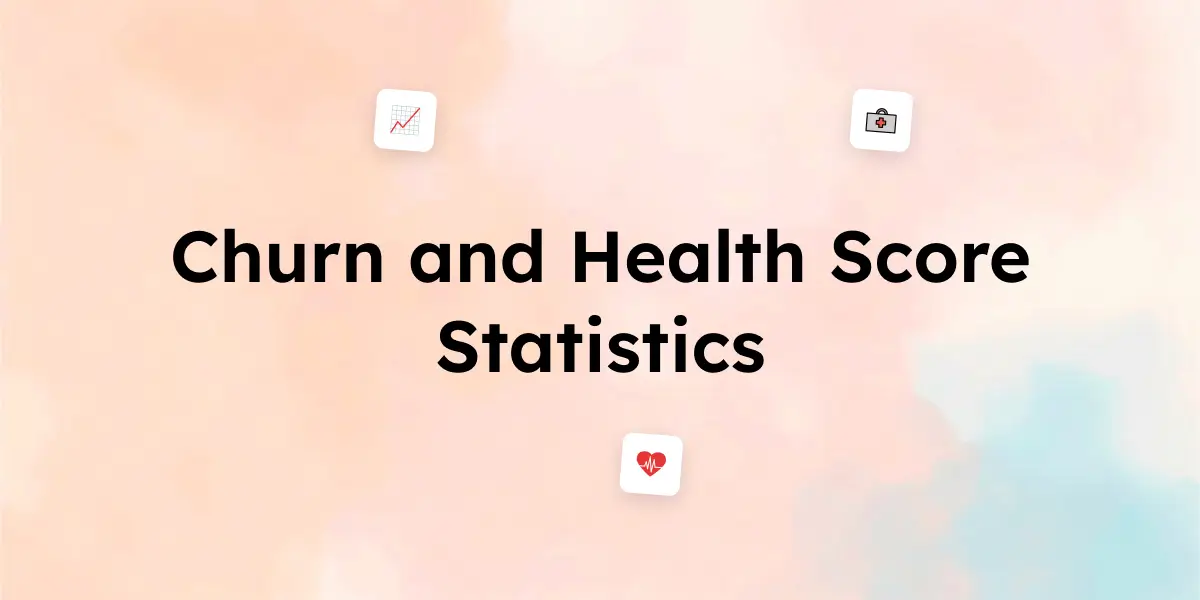Customer retention is more critical than ever in 2025, with businesses across industries focusing on reducing churn and improving customer health scores. Churn, the percentage of customers who stop using a service, directly impacts revenue and growth. Meanwhile, customer health scores help predict churn risk, providing businesses with actionable insights to improve engagement.
This article presents 50+ key churn and health score statistics for 2025, covering industry benchmarks, trends, and best practices. Whether you’re in SaaS, eCommerce, telecom, or any subscription-based business, these data-driven insights will help you enhance retention strategies and maximize customer lifetime value.
50+ Churn and Health Score Statistics
📊 Customer Churn & Retention
- Global average churn rate: ~25% across industries (varies widely).
- SaaS churn rate: ~5-7% annually for enterprise, 10-15% for SMBs.
- Subscription businesses lose ~30% of customers annually due to churn.
- B2B churn is lower (~5%) compared to B2C (~25%), due to contract length.
- 80% of customers who churn say it was preventable with better engagement.
- Reducing churn by 5% can increase profits by 25-95% (Harvard Business Review).
- Acquiring a new customer is 5-7x more expensive than retaining one.
- Brands with loyalty programs see 3x lower churn.
- Customers with poor onboarding experiences churn 2.1x more.
- Netflix churn rate: ~2.5% (one of the lowest among subscription services).
🩺 Health Score & Customer Engagement Stats (2025)
- Customer health scores predict churn with 85% accuracy.
- Companies with real-time health scores improve retention by 20-30%.
- High health scores lead to a 50% increase in upsell/cross-sell success.
- Loyal customers are 4x more likely to refer new users.
- NPS (Net Promoter Score) over 50 correlates with 2x lower churn.
- Inactive users for 30+ days have a 65% chance of churning.
- 80% of customers will leave after one bad support experience.
- Brands that personalize interactions reduce churn by 40%.
- AI-driven churn prediction models improve accuracy by 20-30%.
- Customers with >90% product adoption have near-zero churn risk.
📈 Industry-Specific Churn Trends (2025)
- Telecom churn: ~20-30% annually.
- Streaming services: ~35% of users cancel within the first year.
- Banking & financial services: ~15% churn annually.
- Retail & eCommerce: ~30% churn in loyalty programs.
- B2B SaaS: Companies with annual contracts see 70% lower churn.
- Mobile apps lose ~80% of users within the first 90 days.
- Churn for fitness apps is ~50% after 3 months.
- Health & wellness platforms: engagement reduces churn by 40%.
- Streaming services with original content reduce churn by 20%.
- E-learning platforms: 60% of users drop off after the first course.
💡 Strategies That Reduce Churn
- Personalized emails can reduce churn by 15-20%.
- Onboarding improvements reduce churn by up to 50%.
- Live chat support reduces churn by 35%.
- Proactive customer support lowers churn by 25%.
- Annual billing reduces churn by 30-40% compared to monthly plans.
- Customer education programs increase retention by 2x.
- In-app engagement nudges reduce churn by 20%.
- Usage-based pricing models have 25% lower churn.
- Predictive analytics can flag at-risk customers with 90% accuracy.
- AI chatbots improve engagement and reduce churn by 15%.
🔍 Key Customer Behavior Insights
- 70% of churned users cite lack of perceived value as the main reason.
- Customers engaging with support teams are 30% less likely to churn.
- Exit surveys show pricing concerns drive 50% of voluntary churn.
- Customers who interact with a brand weekly have 3x lower churn risk.
- 95% of customers will return if a complaint is resolved efficiently.
- Customers who receive personalized offers are 20% less likely to churn.
- Brands with omnichannel engagement see a 25% churn reduction.
- Inactive customers for 14+ days are 2x more likely to churn.
- Free trial users with high engagement convert at a 60%+ rate.
- Social proof (reviews/testimonials) lowers churn risk by 15-25%.
🚀 2025 Trends in Churn Prevention
- AI-powered personalization boosts retention rates by 40%.
- Gamification strategies can reduce churn by up to 20%.
- SMS reminders for renewals reduce churn by 18%.
- Proactive outreach (before churn signals appear) lowers churn by 30%.
- Usage-based pricing models gain traction for reducing B2B churn.
📝 Conclusion
Churn and customer health scores are powerful indicators of business sustainability. As AI, predictive analytics, and personalized experiences become mainstream, companies that proactively manage churn will gain a competitive edge.
Key takeaways from 2025 statistics:
✅ Lowering churn by just 5% can boost profits by up to 95%.
✅ Predictive analytics and AI improve churn forecasting by 20-30%.
✅ Proactive engagement strategies (personalization, loyalty programs) reduce churn by up to 40%.
By leveraging these insights, businesses can retain customers longer, improve satisfaction, and drive sustained revenue growth.
Frequently Asked Questions (FAQs)
1. What is a good churn rate in 2025?
A good churn rate depends on the industry:
SaaS (Enterprise): 5-7% annually
SaaS (SMB): 10-15% annually
Telecom & Subscription Services: 20-30%
Streaming & Mobile Apps: 35-50%
Lower churn is always better, but industry norms vary.
2. What is a customer health score, and why is it important?
A customer health score is a metric that predicts a customer’s likelihood to stay or churn. It typically includes factors like:
Product usage frequency
Support interactions
Engagement levels
Payment history
Businesses use health scores to identify at-risk customers and take proactive retention measures.
3. How can businesses reduce churn in 2025?
Top churn reduction strategies include:
Personalized engagement (emails, in-app messages, SMS reminders)
AI-driven churn prediction models
Loyalty programs and rewards
Better onboarding experiences
Usage-based or flexible pricing models
📚 Sources & References :
1️⃣ Harvard Business Review – The Economics of Customer Retention
2️⃣ Gartner – Churn & Retention Benchmarks (2025)
3️⃣ Forrester Research – Predictive Analytics & Customer Engagement 2025
4️⃣ Statista – SaaS & Subscription Churn Rates 2025
6️⃣ HubSpot – Customer Retention Report 2025



